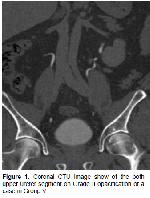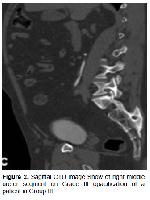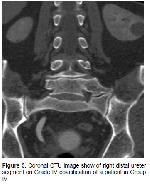CTU is an excretory urogram, which provides a reliable evaluation of the kidneys and urinary system, in which CT is used instead of conventional radiography in the imaging of the urinary system
6. Imaging in the excretory phase following IVCM in CTU doesnt mean that imaging cannot be performed without contrast. Precontrast slices are important in the evaluation of renal parenchyma
7. Imaging was performed from end to end in the non-contrast phase from the top level of the kidneys including the entirety of the bladder
9. Differentiation of urinary system stones, intralesional lipid and calcification content, malignant lesions and non-contrast hyperdense hematomas is important in this phase
1. Cortical cysts, stones and angiomyolipoma were detected in the non-contrast phase images in our study.
An unenhanced scan is initially performed from the upper poles of the kidneys to the lower edge of the symphysis pubis using 3 mm to 5 mm thick sections in the prone position. High attenuation oral contrast should be avoided, as dense contrast can make detection of ureteric calculi more difficult. This is followed by nephrographic phase (90100 seconds after contrast administration) imaging of the kidneys, and excretory phase imaging (815 minutes after contrast administration) of the entire urinary tract 10. Malign lesions ureter wall thickness increase which are denser and more enhanced compared to urine are better detected in the nephrographic phase 1. Septa and wall enhancing (Bosniak Category 3) existed in some of the cortical cysts detected in our study. Heterogeneous enhancing was detected in angiomyolipomas. Excretory phase images are necessary for the evaluation of the lumen of the collecting duct system. Different preparation techniques before CTU have been defined. The purpose of these techniques is to provide maximum distension and full opacification of the urinary tract with the excrete contrast media. It is believed that the sensitivity and specificity of lesion detection will increase when these two factors are optimized 11. There were cases in the present study which had trabeculation detected in the bladder wall in the excretory phase images.
It is difficult for the intrarenal collecting duct system and ureters to have complete opacification in one scan. There are studies using various techniques for optimal urinary tract distension and opacification. Various techniques such as imaging in prone position, abdominal compression, Valsalva maneuver, oral hydration, hydration by intravenous saline, administration of furosemide or antispasmodic agents and multiphase scans are recommended 1,2,9,12-14. No consensus has yet been reached on the preparation stage 7.
Use of furosemide provides the opacification of medial and distal ureters 9,15. Diuretics can increase medial and distal urethral distension compared to hydration alone 15. Groups which had furosemide administered (Groups 3 and 4) had better opacification in the ureters compared to the group which had IV hydration with saline (Group 2). Oral hydration with water doesnt cause an additional cost and provides distension of the collecting duct system with diuresis. However, caution should be exercised in patients with limited fluid intake. Intravenous hydration causes more distension but may stimulate the peristaltic contraction of the ureters 15.
Others have noted that the use of intravenous saline hydration yields opacification of the urinary tract in comparison with that obtained with excretory urography. Several studies have described CTU scanning protocols in western population, using different scanning-phase and contrast media injection protocols 16.
Kawamoto et al. 12 detected that drinking adequate amount of water and adequate absorption from the gastrointestinal system shows similar effects to IV hydration. In our study, we detected that the group which had oral hydration administered had better opacification in the proximal ureter segment compared to the group with IV hydration and that the two groups showed similarity in the medial and distal ureter segments.
To date, a few investigators have suggested that abdominal compression during CTU results in improved opacification of the intrarenal collecting system and ureter, which is similar to the excretory urography 16. On the other hand, Dillman et al. 11, Hage et al. 13 detected that compression doesnt cause a significant difference in urinary tract distension and opacification in CTU. Since caution must be exercised in compression techniques for cases such as acute abdominal pain, history of recent surgery and abdominal aorta aneurism, compression applications were not performed in our study.
The study conducted by Sanyal et al. 17 showed, in support of our study, that use of furosemide causes full opacification in ureters. Bellin et al. 18 detected that the use of furosemide, compared to the use of intravenous saline, forms homogenous distribution of the contrast media in the urinary tract. Lee et al. 14 separated the patients into 3 groups and performed the split bolus technique in each group by giving a different contrast percentage in each bolus. They divided the ureters into proximal, medial and distal segments. They didnt detect a significant difference between the ureter segments and between the groups in their study.
Furosemide provides continuous diuresis and homogeneous opacification of the urinary tract and causes lower attenuation values of excreted urine. Furosemide shouldnt be administered to patients who are known to be allergic to furosemide or other sulphate medications, who have systolic blood pressure below 90 mmHg, acute renal colic and urinary tract obstruction 1.
The techniques used in the preparation stage are oral and/or IV hydration administered before the scan, IV furosemide before IV contrast media, use of abdominal compression devices, inclined patient positioning 19,20. Since the results are equal and most of these techniques are not practical or potentially harmful, oral hydration can be the simplest approach 21.
As can be understood from the conducted studies, many methods to increase the image quality, sensitivity and specificity at every stage of the CTU scan have been tried. Contradicting results were acquired.
We believe that the reason for intravenous saline not increasing ureter opacification compared to other groups was due to the difference in patient population and hydration statuses of patients, saline increasing the peristaltic contractions of ureters and the homogenous diuresis provided by furosemide.







